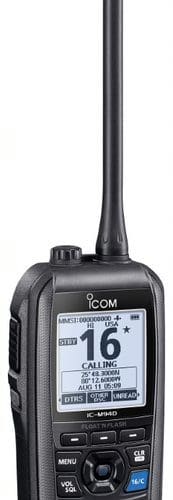
Until recently, the only way you could have a VHF radio with AIS capability in the palm of your hand was through a remote working off a base unit. In my July 2016 ON electronics newsletter, “Wireless remote VHF-AIS radios,” I predicted the eventual advent of the VHF/DSC/AIS/GPS handheld radio. Well, folks, it’s here. Now you can have access to DSC with AIS and GPS in your VHF handheld radio totally independent from your vessel’s VHF base-mount unit.
This new, expanded capability offers a number of advantages. First, if you leave your base unit on while you leave an anchorage in your dinghy to do some exploring, you can find your way back to your yacht even in a dense fog by simply honing in on your boat’s GPS/AIS position on the display screen.
If you enjoy fishing and sightseeing in local waters, you can store waypoints of your favorite sites and use the GPS function to find your way. And again, in limited visibility, you can identify other vessels to be avoided as you navigate among your various stored waypoints.
A leader in this new technology is the Icom M94D Handheld VHF DSC AIS Transceiver, which Icom recently introduced as “the world’s first handheld to possess the power of AIS.” The M94D features a lithium-ion battery with 10 hours of battery life and a dot matrix grayscale LCD display. With 6W of transmit power, it’s just a bit more powerful than the typical 5W handheld radios we have become accustomed to over the last couple of decades.
As with base-mounted AIS-capable VHF radios, the M94D presents a digital display of surrounding vessels, each one identified by name and Maritime Mobile Service Identity (MMSI) code, which is issued to the vessel by the FCC.
A unique feature of the M94D is its AquaQuake draining function, which removes water from the speaker by vibrating at a high frequency, ensuring proper audio function. The unit is rated IPX7 waterproof and sells for a very affordable $300, quite remarkable if you consider the relative newness of this miniaturized technology.
Standard Horizon also makes its version of handheld VHF/AIS/DSC technology available through its HX890NB Floating 6W Class H DSC Handheld VHF/GPS Radio. This unit, available for about $200, is an upgraded version of the earlier HX890, which made its debut soon after the Icom M94D hit the chandlery shelves.
With the GPS function, you can enter waypoints as you would with any other non-charting GPS unit, such as the venerable Garmin 128, which I used on my circumnavigation aboard the 1966 Cal 30 Saltaire. I would have loved having that kind of GPS function combined with a VHF radio and AIS capability.
The HX890 runs off a lithium-ion battery or three standard AAA batteries and is housed in tough polycarbonate housing, which resists crushing under anything just short of a sledge hammer. And unlike virtually every type of electronic device designed for marine use, this radio is navy blue rather than black.
You can get ahead of the line and purchase one of these two fine radios, both progenitors of a new class of electronics, or wait until the market widens into a panoply of competing models with various combinations of features to entice the ocean sailor.
 Circumnavigator-author Bill Morris believes the best strategy for succeeding as an offshore voyager is to keep systems simple and, if possible, manual. Key to survival are a windvane self-steering system, a basic array of electronics and an aggressive alternative energy battery charging matrix. Bill is a frequent contributor to Ocean Navigator and the author of The Windvane Self-Steering Handbook (International Marine, 2004); Sun, Wind, & Water: The Essential Guide to the Energy-Efficient Cruising Boat (Seaworthy Publications, 2017), and The Captain’s Guide to Alternative Energy Afloat (Seaworthy Publications, 2019).
Circumnavigator-author Bill Morris believes the best strategy for succeeding as an offshore voyager is to keep systems simple and, if possible, manual. Key to survival are a windvane self-steering system, a basic array of electronics and an aggressive alternative energy battery charging matrix. Bill is a frequent contributor to Ocean Navigator and the author of The Windvane Self-Steering Handbook (International Marine, 2004); Sun, Wind, & Water: The Essential Guide to the Energy-Efficient Cruising Boat (Seaworthy Publications, 2017), and The Captain’s Guide to Alternative Energy Afloat (Seaworthy Publications, 2019).

